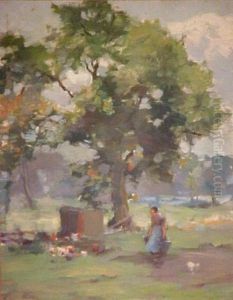George Grey Barnard Paintings
George Grey Barnard was an American sculptor who made significant contributions to the art world in the late 19th and early 20th centuries. Born on May 24, 1863, in Bellefonte, Pennsylvania, he grew up in a time of great artistic ferment in the United States. Barnard showed an early interest in art, and his talent was evident from a young age. He initially studied at the Art Institute of Chicago and later continued his education in Paris, where he was deeply influenced by the work of Auguste Rodin and the naturalism movement in sculpture. This period was crucial for Barnard, as it shaped his artistic vision and honed his skills in sculpture.
Barnard's works are known for their emotional intensity and expressive power. One of his most famous works is the group of sculptures known as 'The Great God Pan,' which showcases his ability to capture both the physical and spiritual aspects of his subjects. His other notable works include 'The Struggle of the Two Natures in Man' and the 'Maidenhood' statue, both of which reflect his interest in human psychology and the complexities of the human condition. Beyond his work as a sculptor, Barnard was also a passionate collector of medieval art. He amassed a significant collection of architectural fragments, sculptures, and decorative objects from Europe, which later became the core of The Cloisters museum in New York City, part of the Metropolitan Museum of Art.
Barnard's contribution to American art was not limited to his creations and collections. He was also a significant figure in the arts community, advocating for public art and the importance of beauty in the urban landscape. His belief in the transformative power of art led him to undertake several public commissions, including the famous Pennsylvania State Capitol sculptures in Harrisburg. Despite facing criticism for some of his more avant-garde works, Barnard remained a respected and influential figure in the art world throughout his career.
George Grey Barnard died on April 24, 1938, in New York City. His legacy lives on through his sculptures, which continue to be admired for their emotional depth and technical mastery. Barnard's life and work exemplify the dynamic and evolving nature of American art at the turn of the century, reflecting the complexities of human experience and the enduring power of artistic expression.




